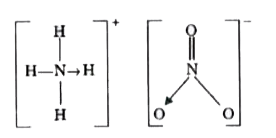The type of bonds present in NH4Cl are
Video Solution
Text Solution

NH+4 ion contains three covalent bonds and one dative bond (formed by the donation of lone pair of electrons on N in NH3 to H+ ion).
NO−3 ion contains covalent and dative bonds.
The bond between NH+4andNO−3 is ionic.
N of NH+4 ion is sp3 hybridised and the shape of NH+4 ion is tetrahedral. N of NO−3 ion is sp6(2) hybridisation and the shape of NO−3 ion is planar.
|
Topper's Solved these Questions
- CHEMICAL BONDING AND MOLECULAR STRUCTUREBOOK - MODERN PUBLICATIONCHAPTER - CHEMICAL BONDING AND MOLECULAR STRUCTUREEXERCISE - OBJECTIVE TYPE QUESTIONS (A. MULTIPLE CHOICE QUESTIONS)
35 Videos
- CHEMICAL BONDING AND MOLECULAR STRUCTUREBOOK - MODERN PUBLICATIONCHAPTER - CHEMICAL BONDING AND MOLECULAR STRUCTUREEXERCISE - OBJECTIVE TYPE QUESTIONS (B. MULTIPLE CHOICE QUESTIONS)
40 Videos
- CHEMICAL BONDING AND MOLECULAR STRUCTUREBOOK - MODERN PUBLICATIONCHAPTER - CHEMICAL BONDING AND MOLECULAR STRUCTUREEXERCISE - Revision Exercises (Objective Questions)(Long Answer Questions)
12 Videos
- CLASSIFICATION OF ELEMENTS AND PERIODICITY IN PROPERTIES BOOK - MODERN PUBLICATIONCHAPTER - CLASSIFICATION OF ELEMENTS AND PERIODICITY IN PROPERTIES EXERCISE - UNIT PRACTICE TEST
13 Videos
Similar Questions
Knowledge Check
The bonds present in NH4Cl is/are
Aonly ionic bondBonly covalent bondConly coordinate covalent bondDAll of the aboveHow many and what types of bonds are present in NH+4?
AFour covalent bondsBThree covalent bonds and one ionic bondCFour ionic bondsDThree covalent bonds and one coordinate bondThe types of bonds present in CuSO4.5H2O are only
AElectrovalent and covalentBElectrovalent and coordinate covalentCElectrovalent, covalent,and coordinate covalentDCovalent and coordinate covalent.
The two types of bonds present in diborane are ………….. and …………...
View SolutionThe types of bonds present in CuSO4⋅5H2O are only
View SolutionThe types of bonds present in CuSO4.5H2O are only
View SolutionType of bonds present in K4[Fe(CN)6] molecule is
View SolutionThe type of bonds present in sulphuric anhydride
View Solution
